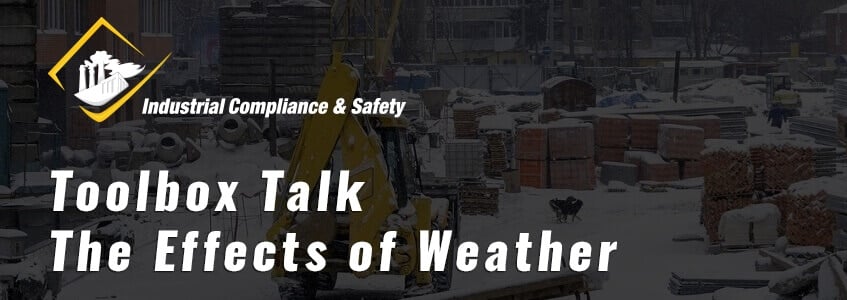Date: ____________________________________
Supervisor: _______________________________
Company Name: _____________________________
Job Name: ______________________________
Download This Toolbox Talk As A Printable Document
Looking for a PDF downloadable version for you to print off for your employees? We've got printable versions here for all of our Toolbox talks if you sign up for our newsletter!
Every contractor must contend with the weather. Regardless of where or when we work, how much money we make, or which client we snag, we have no control over the weather. We can plan and monitor forecasts all we want, but no amount of preparation can prevent a sudden downpour or bout of intense winds. Working in wet weather conditions can be both difficult and dangerous. Therefore, we must always create our construction sites with the weather in mind: we must build in anticipation of the worst, and we must bring supplies that will help protect our bodies and equipment in any scenario.
Guidelines for Discussion:
As a contractor, there are many things that you can do to minimize the effects of weather on your body or worksite. If you check the weather before work every morning, you can get an idea of what to wear to work. Additionally, you can bring some staple items (such as a waterproof jacket) and keep them in your locker or car so that you are always prepared for a sudden shift in weather. Knowing what to expect that day gives you ample time to implement wet, cold, or high wind construction safety protocols.
If you are at work and the weather is unusually windy, be aware that:
- Dust and other debris can blow into your eyes. It might be a good idea to wear a pair of safety goggles, or to at least keep a pair nearby.
- The wind can destabilize fragile structures, such as newly-laid formwork or newly framed walls. Reinforce or protect any structures that may be damaged by the wind.
- The wind can blow materials off scaffolds, roofs or higher floors. Secure materials and other equipment by tying them down, or weighting them down with a heavy object.
- In some extreme cases, the wind can blow people off of scaffolds, roofs, or other tall structures. If the wind seems especially dangerous, refrain from heights if possible until the weather subsides. If a task is urgent, then use all PPE to prevent injuries or falls (such as a harness).
If you are at work while it is raining or snowing and you’re working in wet weather conditions, implement cold weather construction safety measures, such as:
- Wear anti-slip shoes, and wear waterproof gear.
- Be aware of the rain’s effect on visibility. Use a spotter for all operators of heavy equipment/vehicles and keep the site well-lit.
- Snow and ice can obscure floor openings, so be sure to thoroughly mark any openings with signs or guardrails.
- Be aware of the rain’s effect on structural stability. Are newly-completed projects rain-proof? If not, protect work with a tarp or similar coating.
- If you are working in a trench or excavating, monitor the trench walls for slides or stability issues caused by the rain. If you detect any problems with trench stability, refrain from work until the rain stops (THEN reassess the stability of the trench).
- Closely monitor any electrical equipment and extension cords for exposed wiring. Keep all electrical equipment away from heavy rain (and especially keep it from being submerged in water).
If you notice signs of lightning:
- Be aware that electrical storms can occur without any rain.
- Be sure to stay away from any type of tall object.
- If working around iron or rebar and lighting is seen, clear the area.
In the event of any extreme weather, it is important to communicate. Detail any signs of worsening conditions or damage to materials/work to your supervisor. If you don’t feel comfortable completing a task because of wet weather conditions, tell your supervisor.
Additional Discussion Notes:
At the end of this Toolbox Talk, go over the company policy regarding tying down equipment/people when working in wet weather conditions or high winds. Go over all relevant PPE.
Also, name the person who has the authority to shut down a worksite in the event of extreme weather.
Remember to always use common sense and try to minimize the adverse effects of weather.
Safety Recommendations: _____________________
Job Specific Topics: ___________________________
Attendees:
____________________________________
____________________________________
____________________________________
____________________________________
____________________________________
____________________________________
____________________________________
____________________________________
____________________________________
____________________________________
____________________________________
____________________________________
____________________________________
____________________________________
____________________________________
____________________________________
____________________________________
____________________________________
____________________________________
____________________________________
____________________________________
____________________________________
Disclaimer
The information contained within this document (both the online and downloadable version) is provided for informational purposes only. Nobody shall take this as a comprehensive or exhaustive resource on this topic. This material is believed to be accurate, however, the information has been compiled from multiple sources, and so Industrial Compliance & Safety assumes no responsibility for the accuracy of this information. We encourage you to consult experts about this specific Toolbox Talk to ensure you are compliant with any and all safety regulations and processes. In no event does the content of this document supersede any applicable local, state, or federal statutes or regulations.





